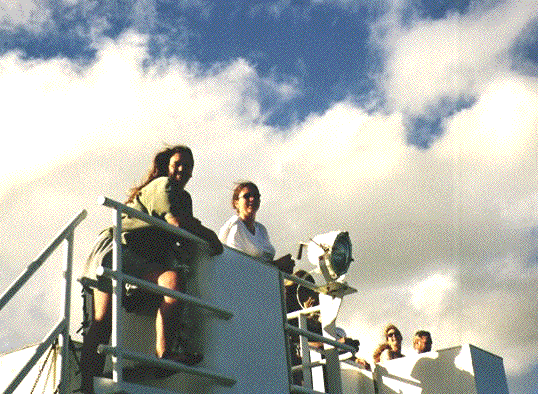|
|
|
|
|
|
Tectonics and Structure of the Manihiki Plateau, Western
Pacific Ocean
Joan Stock, Bruce Luyendyk, Rob Clayton, and shipboard
scientific party
The Manihiki Plateau is an Early Cretaceous large igneous
province located northeast of the Samoan Basin. During May
of 1998, a geophysical survey of the southwest, east, and
northeast flanks of the Plateau was conducted on the R/V
Revelle (KIWI Leg 12). The survey included approximately
4500 km of single-channel seismics, Sea Beam, magnetics and
nine sonobuoy deployments.
Seismic profiling shows the stratigraphic sequence (from
DSDP hole 317) of the Manihiki High Plateau province (MHP)
as basaltic basement, Late Cretaceous clastic sediments and
volcaniclastics, an Eocene cherty chalk, an Oligocene chalk
and a finally a calcareous ooze that is probably Miocene to
Recent in age. This sequence is generally uniform over the
MHP and is only partly preserved in the deeper neighboring
sub-plateau regions. The southwestern edge of the High
Plateau is bounded by the Suvorov Trough. This feature is a
simple asymmetric graben that separates the MHP from a
deeper plateau province (the Nassau Step). Structures found
on the Nassau Step suggest it is an extended terrane. There
is also some evidence of long-wavelength folds lower on the
Step near the Samoan Basin. We suggest that the Step is
deformed by gravity tectonics of Late Cretaceous or Early
Cenozoic age, and that the Suvorov Trough is a breakaway
structure.
At the eastern edge of the MHP the NNE trending Eastern
Scarp comprises a zone (100 km wide) of four to five
parallel linear ridges and basins each with a relief of 500
to 2000m. This ridge and trough region continues south and
north of the MHP. We interpret this feature as a
transtensional dextral fracture zone formed during a change
in spreading direction in Late Cretaceous time. The eastern
part of the MHP appears truncated and may have been sheared
off and transported south to the Gondwana margin at this
time.
The Sea Beam images of the Samoan basin indicate an E-W to
ESE grain in the seafloor topography, while those in the
Penrhyn Basin E of the MHP indicate a ENE pattern. The
magnetics recorded in the Samoan basin are not obviously
correlated with those of other nearby ship tracks. The
magnetics in the Penrhyn basin, at 13-14 degrees S and 159
degrees W, show ENE trending unidentified magnetic
anomalies, consistent with a fracture zone origin of the
Eastern Scarp, but orthogonal to magnetic anomalies reported
from a few hundred km to the north.
Mid-Cretaceous tectonic evolution of the Tongareva triple junction in the southwestern Pacific basin
Larson, R. L., Pockalny, R. A., Viso, R. F., Erba, E., Abrams, L. J., Luyendyk, B. P., Stock, J. M., and R. W. Clayton
